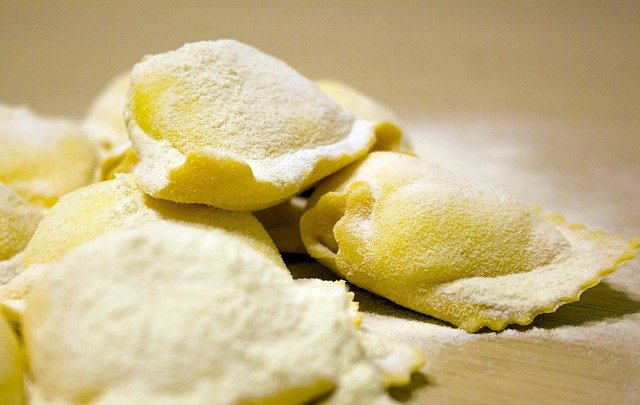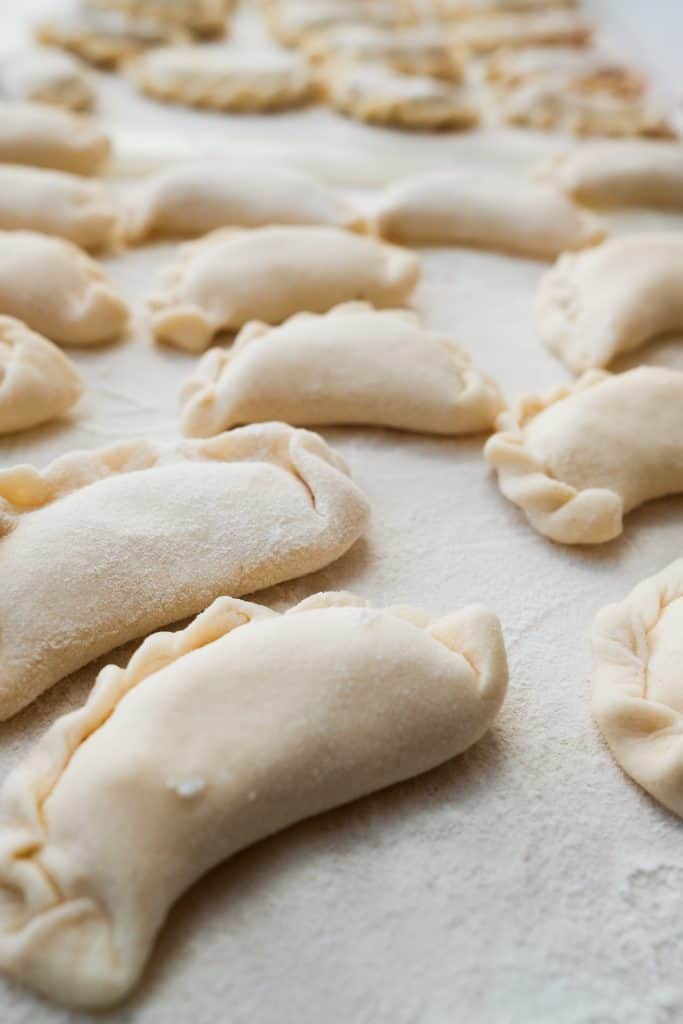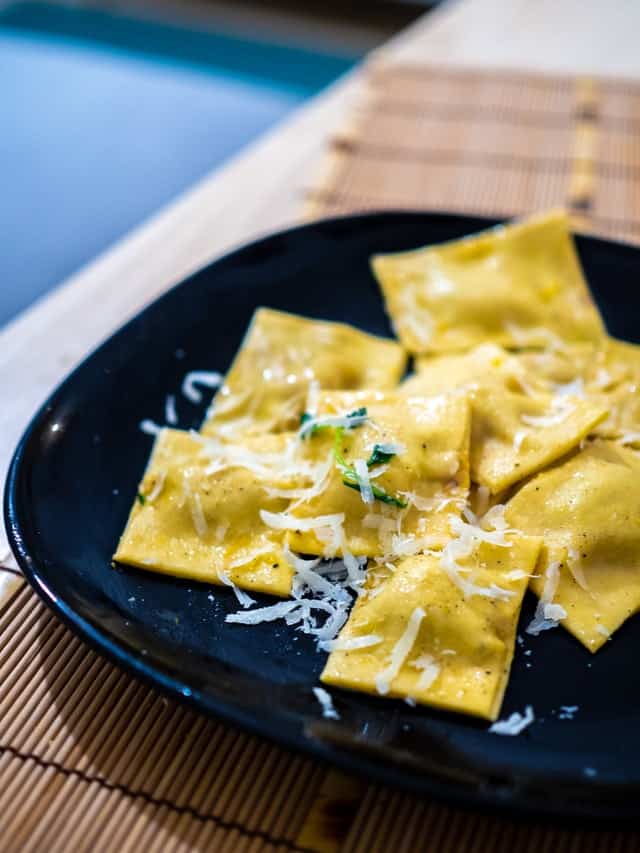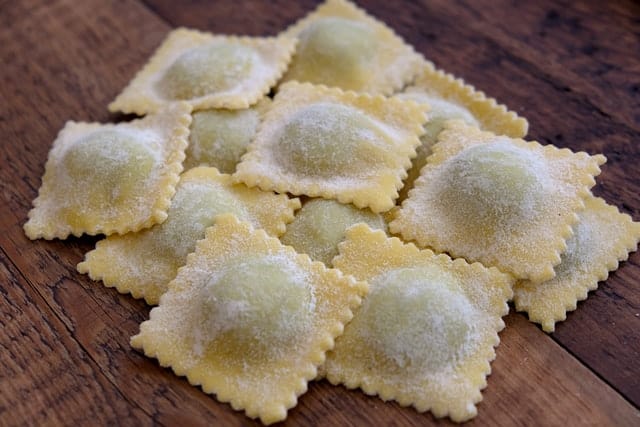You invested so much hard work into making lovely ravioli. When it’s time to cook them, you start pulling them apart, and you get frustrated and angry. But let’s say you dust the ravioli with flour generously and cook them without the cases bursting. You accidentally left them in a colander, and now they are stuck together like glue.
This happened to me in my first years of making ravioli. Then I started to ask myself how to keep ravioli from sticking together? After many attempts, I found the answer:
If you don’t want the ravioli to stick together before cooking, flour the surface on which you will place ravioli, use parchment paper for layering and keep ravioli apart from each other. If you don’t want the ravioli to stick after they are cooked, you have two options, place them in a water bath or coat them with oil.
How to keep ravioli from sticking together before cooking
Ravioli are a fantastic dish, and when we make them, we usually make a lot of them.
Making ravioli is a fun activity, but it also requires a lot of work. The first step to making ravioli is to make pasta dough; then, you make pasta sheets, fill them with your desired filling and shape them into ravioli.
Ravioli are made with pasta dough. If not properly treated, pasta dough can easily stick together.
So, when you are finishing your first batch of ravioli, be sure to put them away correctly. The most important thing is to prepare a suitable place where you will place the ravioli.

Flour
If you are using a pasta board, you can place ravioli on the top part of the pasta board. Pasta boards are not huge, which is why this option can come in handy when you don’t make a lot of ravioli at once. Before you lay them on the wooden surface, it is essential to sprinkle a handful of flour on the board. The flour will prevent the ravioli from sticking to the wooden pasta board.
Although the pasta board is handy, the better solution is to use a flat tray. The tray should be large, so you will have a big surface on which you will place the ravioli. The suitable size is around 18×26 inches (45×66 cm). Just like with a pasta board, generously dust the tray with flour before placing ravioli on the tray.
Plastic trays are the best solution. You can easily put them in the washing machine after use, and there are many different sizes available. You can also easily store or place this tray full of lovely tortellini wherever you want, even into the freezer. The ones I recommend are these:
Parchment paper
If you don’t want to use flour, the other option is to use parchment paper. You can place parchment paper on any surface, on the tray, or on the countertop. Using parchment paper is great, but I still say sprinkle some flour on the parchment paper before placing ravioli on it.
Parchment paper also comes in handy when you want to stack ravioli in layers. Never stack ravioli on top of each other without placing parchment paper between every layer. Also, don’t make too many layers as ravioli will be squashed.
Stacking ravioli without using some divider like parchment paper, is a no-no. If you stack them on top of each other, and even if you dust every layer with flour, you will have problems with sticking. It is also much more challenging to pick them from the tray before cooking without tearing them.
Positioning of ravioli
The best way to put ravioli on the tray to prevent them from sticking together is to place them apart from each other. Each ravioli should be placed on the tray separately without edges overlapping or sticking together.

How to keep ravioli from sticking together after cooking
Ravioli are very fragile and need a gentle hand after they are cooked. If you want to keep them whole and don’t want them to stick together, you really don’t have many options.
The best thing is to coat them with your favorite sauce and eat them right away. This way you won’t have any problems. But there are situations when you need to cook ravioli ahead of time. Storing cooked ravioli can be a pain because cooked ravioli can easily stick together, and you will end up with one giant ravioli when they get cold.
There are some options to prevent ravioli from sticking together after they are cooked. These options don’t completely prevent ravioli from sticking, but they will help you get them apart much easier than if you don’t use these techniques.
Water bath
Since ravioli are full of starch, they will easily stick together when they get cold. One way to prevent this is to do the following:
When ravioli are cooked, drain them thoroughly. It is essential to get as much pasta water off of them as possible. You can still store the pasta water if you want to use it later for the sauce, but if you want to avoid them sticking together, drain them thoroughly.
At this stage, never pour water directly on them. If you open the faucet spout directly on the ravioli, the stream might be too strong, and ravioli cases can tear, and the filling starts running out of ravioli.
To prevent this, pour icy water into a large cooking pot. The amount of water should always be double the quantity of ravioli, or even more. Gently place drained hot ravioli into cold water. Don’t mix or stir the ravioli; just let them float. After a minute, gently drain them and repeat the process one more time.
When you are done, place drained ravioli on a flat surface. Don’t leave them in a colander or cooking pot because they will be stacked too much. It would be best if you place them on a tray on which you placed parchment paper. Ravioli can now easily wait for you to finish them with your favorite sauce.
Olive oil
The other option is to apply oil. To do this, first, drain ravioli completely. Draining ravioli with this option is even more important than when placing them in a water bath.
When you are done, leave ravioli in colander or strainer and drizzle olive oil all over the ravioli. Gently toss the ravioli, so they get evenly coated with oil. The oil will prevent ravioli from sticking but not completely. When they get cold, they will stick together just a bit; that is why it is better to put them on a wide surface when they cool.

Comparing the two options
I use the first option with the water bath when I plan to place the ravioli in a sauce. Ravioli are evenly and better coated with sauce if I use the water bath option.
The olive oil option is better if you plan to pan fry them on some butter and sage or reheat them in a microwave.
Conclusion
Ravioli can easily stick together before or after cooking. Keeping them apart before cooking is much easier than after cooking. My advice is if you want to keep ravioli from sticking together before cooking, use flour, parchment paper and keep them apart. If you have a lot of working surfaces, none of these will be necessary, especially if you will cook them right after you made them. If you wish to keep ravioli from sticking together after cooking, you can’t go wrong by simply coating them with sauce and eating them. But if you don’t have time to cook when the guests arrive, placing them in a water bath or covering them with oil are the best options.



